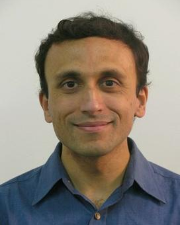
Rahul Sukthankar
http://www.cs.cmu.edu/~rahuls/bio.html
Publication list below is partial. For a complete list, please see: http://www.cs.cmu.edu/~rahuls/pub/.
Publication list below is partial. For a complete list, please see: http://www.cs.cmu.edu/~rahuls/pub/.
Authored Publications
Sort By
Google
Neural Descent for Visual 3D Human Pose and Shape
Andrei Zanfir
Mihai Zanfir
Proceedings of the IEEE/CVF Conference on Computer Vision and Pattern Recognition (CVPR) (2021), pp. 14484-14493
THUNDR: Transformer-based 3D HUmaN Reconstruction with Markers
Mihai Zanfir
Andrei Zanfir
Proceedings of the IEEE/CVF International Conference on Computer Vision (2021)
GHUM & GHUML: Generative 3D Human Shape and Articulated Pose Models
Hongyi Xu
Andrei Zanfir
IEEE/CVF Conference on Computer Vision and Pattern Recognition (Oral) (2020), pp. 6184-6193
Weakly Supervised 3D Human Pose and Shape Reconstruction with Normalizing Flows
Andrei Zanfir
Hongyi Xu
European Conference on Computer Vision (ECCV) (2020), pp. 465-481
Relational Action Forecasting
Abhinav Shrivastava
Carl Martin Vondrick
CVPR 2019
AVA: A Video Dataset of Spatio-temporally Localized Atomic Visual Actions
Carl Martin Vondrick
Jitendra Malik
CVPR (2018)
Rethinking the Faster R-CNN Architecture for Temporal Action Localization
Jia Deng
Yu-Wei Chao
CVPR 2018
Actor-Centric Relation Network
Abhinav Shrivastava
Carl Martin Vondrick
ECCV 2018
